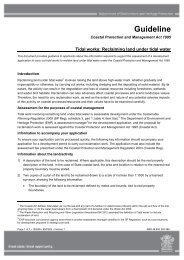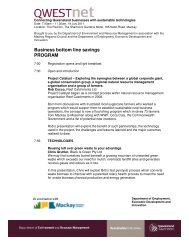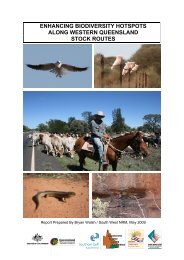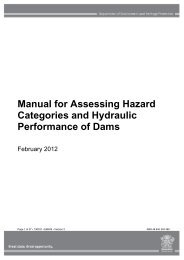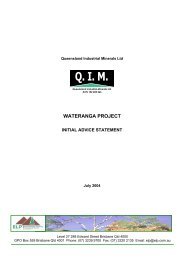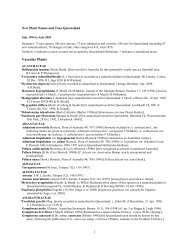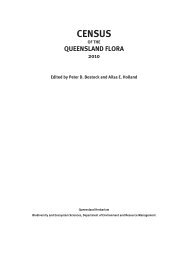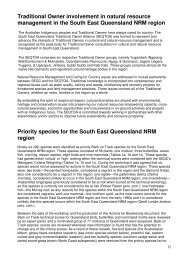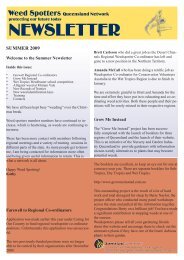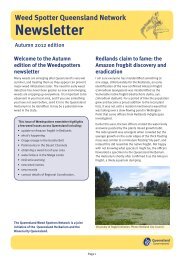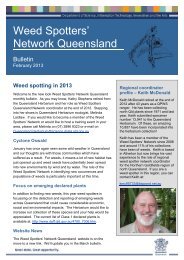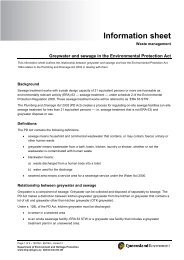Distribution, abundance and biology of Group V humpback whales ...
Distribution, abundance and biology of Group V humpback whales ...
Distribution, abundance and biology of Group V humpback whales ...
Create successful ePaper yourself
Turn your PDF publications into a flip-book with our unique Google optimized e-Paper software.
Figure 4. <strong>Group</strong> IV <strong>and</strong> V distribution <strong>and</strong> migratory routes (Anderson et al.1995)<br />
The southern Great Barrier Reef has shallow (15–60m)<br />
warm waters characteristic <strong>of</strong> <strong>humpback</strong> wintering areas<br />
in Hawaii (Herman <strong>and</strong> Antionoji 1977) <strong>and</strong> the West<br />
Indies (Whitehead <strong>and</strong> Moore 1982). Simmons <strong>and</strong> Marsh<br />
(1985) concluded from their observations that sea surface<br />
temperature is not a determining factor for the distribution <strong>of</strong><br />
<strong>humpback</strong>s.<br />
Two factors indicate that the <strong>humpback</strong> calving grounds<br />
are dispersed throughout Queensl<strong>and</strong> waters, <strong>and</strong> that<br />
parturition occurs along the migratory route. Paterson <strong>and</strong><br />
Paterson (1989) reported a number <strong>of</strong> sightings <strong>of</strong> females<br />
with new calves migrating north past North Stradbroke<br />
Isl<strong>and</strong>; <strong>and</strong> newly-born calves have been recorded str<strong>and</strong>ed<br />
at sites such as Moreton Isl<strong>and</strong> (Paterson et al.1993; Haines<br />
et al.2000) <strong>and</strong> Fraser Isl<strong>and</strong> (Paterson <strong>and</strong> Van Dyke 1991;<br />
Haines et al.2000). Parturition has been observed at a few<br />
locations within the Great Barrier Reef at Little Trunk Reef,<br />
Charity Reef <strong>and</strong> Little Broadhurst Reef (Paterson <strong>and</strong><br />
Paterson 1989).<br />
Chaloupka <strong>and</strong> Osmond (1999) concluded that <strong>humpback</strong>s<br />
are present in all months <strong>of</strong> the year throughout the Great<br />
Barrier Reef Marine Park (GBRMP). This study, <strong>and</strong><br />
earlier study by Simmons <strong>and</strong> Marsh (1985) supported<br />
the hypothesis that <strong>humpback</strong>s are resident year round in<br />
the northern Great Barrier Reef. However Chaloupka <strong>and</strong><br />
Osmond (1999) found that most pods (75 percent) were<br />
sighted in southern GBR waters below 19ºS (Townsville)<br />
<strong>and</strong> mainly during winter <strong>and</strong> spring (July to September).<br />
Humpbacks migrating north are sighted in Queensl<strong>and</strong><br />
waters from late May. Paterson (1984) recorded a distinct<br />
peak in the <strong>abundance</strong> <strong>of</strong> <strong>humpback</strong>s migrating north<br />
during late June <strong>and</strong> July at North Stradbroke Isl<strong>and</strong>.<br />
However, there is no corresponding distinct peak that occurs<br />
during the southern migration that occurs during August,<br />
September <strong>and</strong> October (Paterson 1984).<br />
Winter breeding grounds<br />
(presumed)<br />
Summer feeding grounds<br />
6 • <strong>Distribution</strong>, <strong>abundance</strong> <strong>and</strong> <strong>biology</strong> <strong>of</strong> <strong>Group</strong> V <strong>humpback</strong> <strong>whales</strong> Megaptera novaeangliae: A review • August 2002<br />
During August <strong>and</strong> September, Chaloupka <strong>and</strong> Osmond<br />
(1999) reported low sightings <strong>of</strong> mother-calf pairs in most<br />
areas below 21ºS for the period 1982–1999. They suggested<br />
that the main calving grounds for the east Australian <strong>Group</strong><br />
V population occur in the extensive southern GBR lagoonal<br />
waters defi ned in the north by the Whitsunday <strong>Group</strong> <strong>of</strong><br />
isl<strong>and</strong>s <strong>and</strong> reefs <strong>and</strong> in the east by the Pompey/Swain<br />
Reefs complex. In recent years, anecdotal information<br />
suggests that <strong>humpback</strong>s are abundant further north<br />
in areas <strong>of</strong>fshore <strong>of</strong> Cairns <strong>and</strong> as late in the year as<br />
November.<br />
4.4.1 Moreton Bay region<br />
Historically, a whaling station was based on Moreton Isl<strong>and</strong>.<br />
Paterson <strong>and</strong> Paterson (1984) summarised the history <strong>of</strong><br />
exploitation in relation to a discussion <strong>of</strong> the patterns <strong>of</strong><br />
migration. They concluded that the migratory patterns had<br />
not altered as a result <strong>of</strong> the commercial exploitation.<br />
The Moreton Bay region is best described as a migratory<br />
corridor for <strong>humpback</strong>s although other components <strong>of</strong> their<br />
<strong>biology</strong> may also occur here. Paterson (1994) observed<br />
parturition on one occasion <strong>and</strong>, str<strong>and</strong>ed newly-born calves<br />
have been recorded on several occasions (Paterson et<br />
al.1993; Haines et al.2000; 2001).<br />
For the past 20 years, two independent l<strong>and</strong>-based<br />
censuses have been conducted from Point Lookout,<br />
North Stradbroke Isl<strong>and</strong>, or Moreton Isl<strong>and</strong>, Queensl<strong>and</strong><br />
(Bryden et al.1996 <strong>and</strong> Paterson, Paterson <strong>and</strong> Cato 1994).<br />
In 1998, a brief overview <strong>of</strong> the population estimates <strong>and</strong><br />
rates <strong>of</strong> population increase were presented at a workshop<br />
(Department <strong>of</strong> Environment <strong>and</strong> Heritage 1999).



